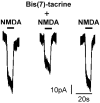Bis(7)-tacrine protects retinal ganglion cells against excitotoxicity via NMDA receptor inhibition
- PMID: 22553626
- PMCID: PMC3340694
- DOI: 10.3980/j.issn.2222-3959.2011.02.03
Bis(7)-tacrine protects retinal ganglion cells against excitotoxicity via NMDA receptor inhibition
Abstract
Aim: To investigate whether bis(7)-tacrine, a multifunctional drug, inhibits N-methyl-D-aspartate (NMDA) -activated current in retinal ganglion cells(RGC) and provides neuroprotection against retinal cell damage.
Methods: Purified RGC cultures were obtained from retinas of 1-3 days old Sprague-Dawley(SD) rats, following a two-step immunopanning procedure. After 7 days of cultivation, the inhibition of NMDA-activated current by bis(7)-tacrine was measured by using patch-clamp recording techniques. In animal experiments, RGCs were damaged after intravitreal injection of NMDA (5µL, 40nmol) in adult rats. Bis(7)-tacrine(0.05, 0.1, 0.2mg/kg) or memantine(20mg/kg) was intraperitoneal administered to the rats fifteen minutes before intravitreally injection of NMDA. RGC damage was analyzed by histologic techniques, TUNEL and retrograde labeling techniques.
Results: Whole-cell patch-clamp recordings demonstrated that NMDA (30µmol/L) resulted in approximately -50 pA inward currents that were blocked by bis(7)-tacrine(1µmol/L). Histological examination and retrograde labeling analysis revealed that bis(7)-tacrine induced a significant neuroprotective effect against NMDA-induced cell damage 7 days after NMDA injection. TUNEL staining showed that pretreatment with bis(7)-tacrine was effective in ameliorating NMDA-induced apoptotic cell loss in the retinal ganglion cell layer 18 hours after injection.
Conclusion: Bis(7)-tacrine possesses remarkable neuroprotective activities against retinal excitotoxicity through inhibition of NMDA receptors.
Keywords: N-methyl-D-aspartate receptors; bis(7)-tacrine; excitotoxicity; neuroprotection.
Figures




References
-
- Casson RJ. Possible role of excitotoxicity in the pathogenesis of glaucoma. Clin Experiment Ophthalmol. 2006;34(1):54–63. - PubMed
-
- Gilling KE, Jatzke C, Hechenberger M, Parsons CG. Potency, voltage-dependency, agonist concentration-dependency, blocking kinetics and partial untrapping of the uncompetitive N-methyl-d-aspartate (NMDA) channel blocker memantine at human NMDA (GluN1/GluN2A) receptors. Neuropharmacology. 2009;56(5):866–875. - PubMed
-
- Osborne NN. Recent clinical findings with memantine should not mean that the idea of neuroprotection in glaucoma is abandoned. Acta Ophthalmol. 2009;87(4):450–454. - PubMed
-
- Danesh-Meyer HV, Levin LA. Neuroprotection: extrapolating from neurologic diseases to the eye. Am J Ophthalmol. 2009;148(2):186–191. - PubMed
-
- Fu H, Li W, Luo J, Lee NT, Li M, Tsim KW, Pang Y, Youdim MB, Han Y. Promising anti-Alzheimer's dimer bis(7)-tacrine reduces beta-amyloid generation by directly inhibiting BACE-1 activity. Biochem Biophys Res Commun. 2008;366(3):631–636. - PubMed
LinkOut - more resources
Full Text Sources
Miscellaneous
